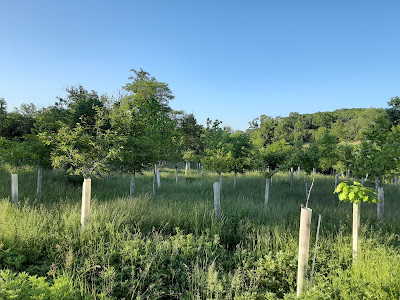Right now, on the cusp of July, birdsong is heard once again in my yard.
 |
| Apples (Margo D. Beller) |
That's because the young that had been protected in their nests by their parents are now flying around after them, begging for food. The parents, in turn, send out contact calls to make sure everyone stays together. Now, about a month after the northbound migrants moved through and the nesting birds went silent, I am hearing songs or calls again: catbird, song sparrow, titmouse, house finch, white-breasted nuthatch, cardinal, assorted woodpeckers. Some of these birds may have second broods, but for now the emphasis is on teaching the first brood to take care of itself.
The house wrens in my yard have also been on the move. Once again I did not see the moment when the young, no doubt cramped in such a small space in hot, humid weather, took off after their parents. On Friday morning, June 23, the parents were busy feeding the young, hanging outside the box except for when one would go inside to clean out the poop. I could see the heads of the young as they came to the opening and looked out. They seemed very agitated.
On Saturday morning, June 24, we had a deluge for the first time in weeks. I stayed inside. When it was over I went outside to pull out stubborn weeds from my front walkway (stubborn because of long taproots, which gave easily in the soggy soil). When I walked to my compost pile to dump them I heard the scolding of a house wren, then the dry, rattle-like calls of young. Sure enough, as I sat to rest on my porch, I watched the nest box and saw no activity. Once again, these birds had flown.
 |
| Empty nest (Margo D. Beller) |
My guess is they flew Friday afternoon. Since then they have been moving between my yew hedge and the shrubby area near my compost pile. In fact, today, when I went to that shrubby area to pull out a tree branch to add to my brush pile, five wrens jumped out! A parent and four young? Two parents and three young? All young? I don't know. I quickly left the area and they settled down.
Here is a video I found that shows five wrens fledging. (The video lasts about five minutes. The site is not associated with mine.)
Meanwhile, the apple tree has brought forth a prodigious amount of fruit, right on time. I am usually busy picking apples from late June into early July. People I know with their own apple trees think it odd that my apples are not ready for harvest in the fall. However, doing a bit of searching, I found that there are many types of early apple varieties. I'm not sure which of them is mine.
Starting last week, I was knocking apples down with an extension pole because thanks to the tree pruning in January the lower, more easily reached branches are gone. I've managed to fill a bucket with enough apples for me to make apple sauce, when I get around to it. For now, the fruit is stored in my cellar.
 |
| (Margo D. Beller) |
The squirrels always seem to know when the apples are ripe and they have been eating the fruit regularly. I am also making regular visits, but to dispose of what they've eaten and dropped before the deer (or bear?) can get to it. Sometimes there is even fruit for me. I cut into one of the apples I picked up today and it doesn't taste particularly sweet - almost all the apples are on the green side - but for a hungry or thirsty squirrel they will do.
I have taken down what large fruit I can reach. I must now depend on squirrels, or one of the many intense thunderstorms we've been suffering through this week, to knock down any other apples. Then I must get them before the deer.
 |
| Treed squirrel (Margo D. Beller) |
It is gratifying to me that, after all these years, the apple tree continues to produce despite heavy pruning (and whacking at the branches by me). I'm sure the squirrels are happy about it, too. We'll all enjoy it while it lasts.








